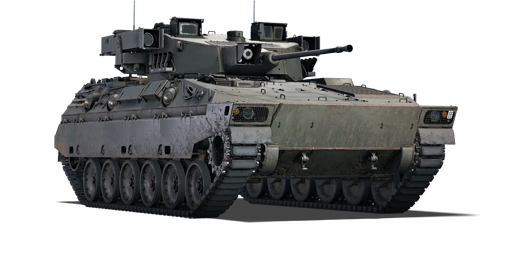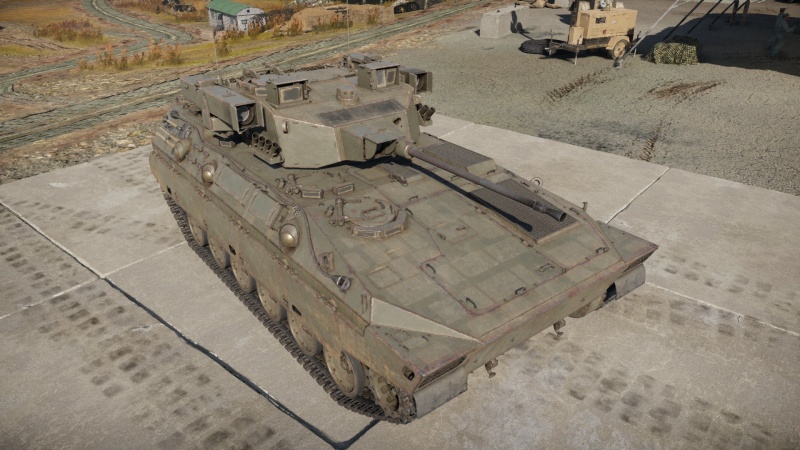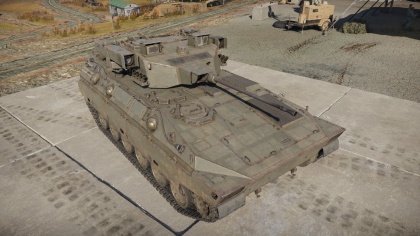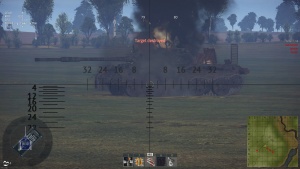Difference between revisions of "Type 89"
Colok76286 (talk | contribs) (→Ammunition: Updated table templates and corrected some values) |
|||
| Line 1: | Line 1: | ||
| − | {{Specs-Card|code=jp_type_89}} | + | {{Specs-Card |
| + | |code=jp_type_89 | ||
| + | |images={{Specs-Card-Image|GarageImage_{{PAGENAME}}.jpg}} | ||
| + | }} | ||
{{About | {{About | ||
| about = '''Type 89 IFV''' | | about = '''Type 89 IFV''' | ||
| Line 15: | Line 18: | ||
== General info == | == General info == | ||
=== Survivability and armour === | === Survivability and armour === | ||
| + | {{Specs-Tank-Armour}} | ||
<!-- ''Describe armour protection. Note the most well protected and key weak areas. Appreciate the layout of modules as well as the number and location of crew members. Is the level of armour protection sufficient, is the placement of modules helpful for survival in combat? If necessary use a visual template to indicate the most secure and weak zones of the armour.'' --> | <!-- ''Describe armour protection. Note the most well protected and key weak areas. Appreciate the layout of modules as well as the number and location of crew members. Is the level of armour protection sufficient, is the placement of modules helpful for survival in combat? If necessary use a visual template to indicate the most secure and weak zones of the armour.'' --> | ||
| Line 68: | Line 72: | ||
=== Mobility === | === Mobility === | ||
| + | {{Specs-Tank-Mobility}} | ||
<!-- ''Write about the mobility of the ground vehicle. Estimate the specific power and manoeuvrability, as well as the maximum speed forwards and backwards.'' --> | <!-- ''Write about the mobility of the ground vehicle. Estimate the specific power and manoeuvrability, as well as the maximum speed forwards and backwards.'' --> | ||
| Line 79: | Line 84: | ||
As with [[Type 60 SPRG (C)]], reverse gear is much more responsive and will allow you to manoeuvre and retreat back around the corner during combat - use it if tank was forcibly stopped. | As with [[Type 60 SPRG (C)]], reverse gear is much more responsive and will allow you to manoeuvre and retreat back around the corner during combat - use it if tank was forcibly stopped. | ||
| + | |||
| + | === Modifications and economy === | ||
| + | {{Specs-Economy}} | ||
== Armaments == | == Armaments == | ||
| + | {{Specs-Tank-Armaments}} | ||
=== Main armament === | === Main armament === | ||
| + | {{Specs-Tank-Weapon|2}} | ||
| + | {{Specs-Tank-Weapon|1}} | ||
<!-- ''Give the reader information about the characteristics of the main gun. Assess its effectiveness in a battle based on the reloading speed, ballistics and the power of shells. Do not forget about the flexibility of the fire, that is how quickly the cannon can be aimed at the target, open fire on it and aim at another enemy. Add a link to the main article on the gun: <code><nowiki>{{main|Name of the weapon}}</nowiki></code>. Describe in general terms the ammunition available for the main gun. Give advice on how to use them and how to fill the ammunition storage.'' --> | <!-- ''Give the reader information about the characteristics of the main gun. Assess its effectiveness in a battle based on the reloading speed, ballistics and the power of shells. Do not forget about the flexibility of the fire, that is how quickly the cannon can be aimed at the target, open fire on it and aim at another enemy. Add a link to the main article on the gun: <code><nowiki>{{main|Name of the weapon}}</nowiki></code>. Describe in general terms the ammunition available for the main gun. Give advice on how to use them and how to fill the ammunition storage.'' --> | ||
{{main|Oerlikon KDE (35 mm)}} | {{main|Oerlikon KDE (35 mm)}} | ||
| Line 279: | Line 290: | ||
=== Machine guns === | === Machine guns === | ||
| + | {{Specs-Tank-Weapon|3}} | ||
<!-- ''Offensive and anti-aircraft machine guns not only allow you to fight some aircraft but also are effective against lightly armoured vehicles. Evaluate machine guns and give recommendations on its use.'' --> | <!-- ''Offensive and anti-aircraft machine guns not only allow you to fight some aircraft but also are effective against lightly armoured vehicles. Evaluate machine guns and give recommendations on its use.'' --> | ||
{{main|Type 74 (7.62 mm)}} | {{main|Type 74 (7.62 mm)}} | ||
Revision as of 09:43, 28 December 2020
Contents
| This page is about the Type 89 IFV. For equipment of the same adoption year, see Type 89 (Disambiguation). |
Description
The Type 89 is a rank VI Japanese light tank
with a battle rating of 9.0 (AB/RB/SB). It was introduced in Update 1.85 "Supersonic".
The full name is known as the Mitsubishi Type 89 infantry fighting vehicle (Japanese: 三菱89式装甲戦闘車 - Mitsubishi 89-shiki sōkō-sentō-sha), the Type 89 provides an autocannon weapon combined with an anti-tank guided missile for a diverse range of attack methods.
General info
Survivability and armour
While the Type 89's armour consists of Rolled Homogenous Armour, it is not any better than modern light tanks of other factions, which use double or even triple the amount of aluminium to give roughly the same amount of protection. This means that its sides and even angled turret will still be vulnerable to all autocannons and will "hull break" easily if hit in a weak spot. One such weak spot is the suspension, for example, hitting the back wheels of the chassis with a 105 mm chemical shell may annihilate the entire tank. Any 120 mm and higher kinetic shells hitting the hull will also likely instantly hull break it.
The armour profile can be closely compared to Merkava Mk.1, it has a long hull with turret on the back, and the entirety of it is sloped as much as possible. This means that inaccurate frontal hull shots will likely bounce and this tank should always face the opponent. Unfortunately, due to how big the turret is, the bounced shell might actually fly straight into it, and there aren't any special shields or additional armour for the turret crew on this tank.
Internal module placement is rather smart on paper, with the driver and MG operator hiding on the right side of the tank, and main weapon crew hiding at the back along with ammunition, while the rest of the tank is one giant engine compartment, sealed off with a 5 mm RHA screen. In reality, the means of protecting the crew and critical weak points are insufficient. Most notably, the driver isn't completely sealed away from tank's front and the turret.
Due to overall low thickness of armour Type 89 can get overmatched. Whenever the tank hull side is even slightly opened, it will get easily penetrated by big guns, the armour is thick enough to trigger APHE fuses and even if it's a slow 19 mm fuse it will trigger off hitting the engine and RHA screen, then cause violent explosions next to ammo rack, aside from the already extreme likelihood of a hullbreak. Pure AP shells even of a small calibre autocannon will fly straight through the entire engine compartment, likely hitting the turret crew or ammo rack in the very back of the tank. It is also possible to lose the entire tank crew to a single coaxial autocannon spray from the right side, as nothing is protecting the driver there.
The one scenario in which the sealed compartment can truly work is when the Type 89 is driving around the town, or hiding from snipers behind buildings, and someone suddenly shoots engine compartment into direction opposite from the crew, then enemy APHE may simply get stuck there, doing reduced damage to the turret crew. This does not make the situation any better though, as without team help or a very unlikely ATGM counterattack, Type 89 will still get repeatedly set on fire until it explodes.
Recommendations: Keep your opponents in front of you, if you can't - at least keep them on your left. Avoid being shot directly by 120+ mm shells. Do not needlessly taunt enemy SPAA. In close quarters you can be extremely aggressive and destroy enemy weapon or gunner as soon as possible. Otherwise try to scout enemies and hope to fire first or that there is a sniper to cover your back.
| Armour | Front (Slope angle) | Sides | Rear | Roof |
|---|---|---|---|---|
| Hull | 15 mm - 20 mm (81°) Upper Glacis
5 mm (81°) Ventilation (Upper Glacis) 35 mm (26°-57°) Lower Glacis 20 mm (0°-50°) Sponson Front |
20 mm Upper
15 mm (Base) +10 mm (Sideskirts) Lower |
15 mm | 5 mm - 20 mm |
| Turret | 35 mm (11°-12°) Turret Front Sides
25 mm + 25 mm Gun mantlet |
20 mm | 15 mm (Base) + 5 mm (Storage Rack) | 10 mm |
| Cupola | 10 mm | |||
Notes:
- Main Gun, ATGM Launchers, Machine Gun - 10 mm
- Fenders, Storage - 5 mm
- Turret Ring - 25 mm
- Tracks - 15 mm
- Suspension - 10 mm
- There are 10 mm or armor protection between the engine compartment and the crew compartment on the inside of the vehicle
Mobility
| Game Mode | Max Speed (km/h) | Weight (tons) | Engine power (horsepower) | Power-to-weight ratio (hp/ton) | |||
|---|---|---|---|---|---|---|---|
| Forward | Reverse | Stock | Upgraded | Stock | Upgraded | ||
| Arcade | 78 | 48 | 26.5 | 930 | 1,145 | 35.09 | 43.21 |
| Realistic | 71 | 43 | 531 | 600 | 20.04 | 22.64 | |
On hard, flat terrain, the Type 89 will easily keep pace or out-speed many other vehicles due to it's reasonable power-to-weight ratio of 23 hp/t.
On soft, uneven or hilly terrain the Type 89 loses a lot of its speed advantage. This is due to the fact that the gearbox only provides 4 separate forward speeds. Due to the long gearing the Type 89 will often find itself unable to climb hills in gear 2 and will have to change to gear 1, which provides a top speed of just 9 km/h for hill-climbing. This means the Type 89 is often less mobile on hilly terrain than medium tanks. This problem can be mitigated to some extent by maintaining a good amount of speed (30+ km/h) and not stopping when travelling up hills.
It is impossible to drive forward and turn at the same time while in forward gear 1, which is a huge detriment in melee combat. Driver has to either turn with neutral steer while being stationary, or speed up enough to shift to gear 2 and then turn.
As with Type 60 SPRG (C), reverse gear is much more responsive and will allow you to manoeuvre and retreat back around the corner during combat - use it if tank was forcibly stopped.
Modifications and economy
Armaments
Main armament
The Type 89 is equipped with a 35 mm Oerlikon KDE autocannon, which is similar to the KDA variant used by the Gepard, the Type 87, and the Chieftain Marksman, and is widely considered to be one of the most effective guns in regards to damage output and reliability. This is due to their moderate calibre and rate of fire: 35 mm is the largest of the small autocannons which allows it to have a much higher rate of fire than any 40 mm or 57 mm system.
The difference between them is that KDE cannon fires slower than KDA, but it uses tank-specific ammunition instead, which makes it behave differently - for example, API-T will explode after penetration regardless of armour thickness (because planes have no armour), while APHE will explode only if it penetrates about 9 to 15 mm equivalent of Rolled Homogenous Armour, like with any normal tank shells. However, it generally does slightly more damage, if it does explode. Due to this, KDE shells also have a tendency to penetrate modules like thin radiators and sometimes even engines, instead of just exploding upon hitting them, thus doing more damage on average when attacking light tanks.
It is very important to remember that even 3-5 direct APHE hits to a cannon barrel can neutralize almost any medium tank Type 89 can face, and should anything impenetrable suddenly attack, one can just destroy their gun to avoid being shot at.
This autocannon allows the Type 89 to easily deal with any lightly armoured vehicle in the game. It also has access to APDS ammunition, which allows it to deal with Main Battle Tanks from the side, though this is usually not advised. It is also advisable to avoid attacking tanks like M3 Bradley from long range with a gun without APDS ammunition, as this light tank mostly specializes in annihilating other light tanks, has APDS from the get-go and its hull can block almost any weak long range shots, including the stock APHE.
Tank still can use conventional HE to attack helicopters, if it must. Remember to use laser rangefinder to target them quicker when it's researched.
Whenever you see that the main gun can't deal with an enemy target, or someone caught you off guard, consider using the ATGMs instead.
| 35 mm Oerlikon KDE | Turret rotation speed (°/s) | Reloading rate (seconds) | ||||||||||||
|---|---|---|---|---|---|---|---|---|---|---|---|---|---|---|
| Mode | Capacity (Belt) | Fire rate | Vertical | Horizontal | Stabilizer | Stock | Upgraded | Full | Expert | Aced | Stock | Full | Expert | Aced |
| Arcade | 255 (17) | 200 | -9°/+60° | ±180° | Two-plane | 57.12 | 79.06 | 96.00 | 106.16 | 112.94 | 1.30 | 1.12 | 1.06 | 1.00 |
| Realistic | 35.70 | 42.00 | 51.10 | 56.40 | 60.40 | |||||||||
Ammunition
| Penetration statistics | |||||||
|---|---|---|---|---|---|---|---|
| Ammunition | Type of warhead |
Penetration @ 0° Angle of Attack (mm) | |||||
| 10 m | 100 m | 500 m | 1,000 m | 1,500 m | 2,000 m | ||
| DM13 | APHE | 68 | 65 | 52 | 40 | 30 | 23 |
| DM11A1 | HE | 5 | 5 | 5 | 5 | 5 | 5 |
| DM23 | APDS | 127 | 125 | 119 | 111 | 104 | 97 |
| Shell details | |||||||||
|---|---|---|---|---|---|---|---|---|---|
| Ammunition | Type of warhead |
Velocity (m/s) |
Projectile Mass (kg) |
Fuse delay (m) |
Fuse sensitivity (mm) |
Explosive Mass (TNT equivalent) (g) |
Ricochet | ||
| 0% | 50% | 100% | |||||||
| DM13 | APHE | 1,175 | 0.55 | 1.2 | 9.0 | 37.4 | 47° | 60° | 65° |
| DM11A1 | HE | 1,175 | 0.55 | 0.0 | 0.1 | 204 | 79° | 80° | 81° |
| DM23 | APDS | 1,400 | 0.38 | N/A | N/A | N/A | 75° | 78° | 80° |
Ammo racks
| Full ammo |
1st rack empty |
2nd rack empty |
3rd rack empty |
4th rack empty |
5th rack empty |
6th rack empty |
7th rack empty |
8th rack empty |
9th rack empty |
10th rack empty |
11th rack empty |
12th rack empty |
13th rack empty |
14th rack empty |
15th rack empty |
Visual discrepancy |
|---|---|---|---|---|---|---|---|---|---|---|---|---|---|---|---|---|
| 15 | 15 (+0) | 14 (+1) | 13 (+2) | 12 (+3) | 11 (+4) | 10 (+5) | 9 (+6) | 8 (+7) | 7 (+8) | 6 (+9) | 5 (+10) | 4 (+11) | 3 (+12) | 2 (+13) | 1 (+14) | No |
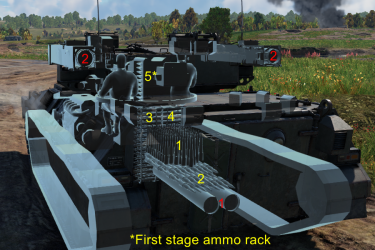
Additional armament
The Type 79 ATGM has around 700 mm flat penetration at any range and has start velocity of 200 m/s, while retaining the high explosive mass of the Type 64 MAT, making it one of the better ATGMs of the rank, similar to the Warrior's MILAN 2. This ATGM can deal with most tanks from the front, but be sure to avoid hitting modern NATO NERA composite armour, as these composite armours will minimise the damage done or even negate it entirely. When facing tanks with active ERA screens like M60A1 RISE (P), attack the screen with cannon first, if possible, as such ERA plating may reduce damage taken by hostile tank and force you to use both missiles to take them down.
Two missiles are located on sides of a turret, with two reserves being stored in the back of the hull (four total). Due to their placement, they only really arrive at crosshair location if target is over 500 m away, so use them on targets which are away from the tank and practice aim in test drive to be able to use them at melee ranges, instead of relying on targeting reticle.
Missiles can be launched on the move at any speed as with hybrid medium tanks, user does not have to and should not slow down or stop tank to use them, as missile pointer is stabilized. The second missile can be immediately fired after the first one, but firing it will cut off guidance for the first one, so only do this if you are sure it's on correct course.
Keep in mind, that missile reload is only possible after both of them were fired, and it takes 30 seconds, which is arguably the longest ATGM reload time in the game - while it's matching average per-missile reload time of a medium tank, it is overall twice slower than medium tank ATGM reload, three times slower than average reload of single-launcher light tanks and about six times slower than reload of dual-launcher specialized ATGM tanks.
| Type 79 missile | Reloading rate (seconds) | ||||||
|---|---|---|---|---|---|---|---|
| Mode | Capacity (Belt) | Fire rate | Vertical | Stock | Full | Expert | Aced |
| Arcade | 4 (2) | 120 | 0°/+12° | _.__ | _.__ | _.__ | _.__ |
| Realistic | |||||||
Ammunition
| Penetration statistics | |||||||
|---|---|---|---|---|---|---|---|
| Ammunition | Type of warhead |
Penetration @ 0° Angle of Attack (mm) | |||||
| 10 m | 100 m | 500 m | 1,000 m | 1,500 m | 2,000 m | ||
| Type 79 | ATGM | 700 | 700 | 700 | 700 | 700 | 700 |
| Shell details | ||||||||||
|---|---|---|---|---|---|---|---|---|---|---|
| Ammunition | Type of warhead |
Velocity (m/s) |
Range (m) |
Projectile Mass (kg) |
Fuse delay (m) |
Fuse sensitivity (mm) |
Explosive Mass (TNT equivalent) (g) |
Ricochet | ||
| 0% | 50% | 100% | ||||||||
| Type 79 | ATGM | 200 | 4,000 | 19.90 | 0.0 | 0.1 | 4,200 | 80° | 82° | 90° |
Ammo racks
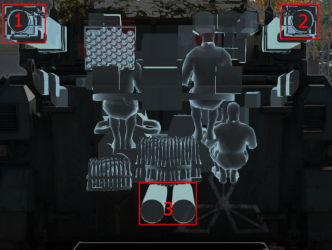
| Full ammo |
Visual discrepancy |
|---|---|
| 4 | No |
Notes:
- It is not possible to select how many missiles to bring into battle.
- The left ATGM is fired first.
- The reload process will only begin when both ATGM have been fired off the Type 89's side launchers
Optics and night vision
The Type 89 receives night vision imagers once the tier 3 modification 'NVD' is researched. This unlocks standard 500 x 300 resolution thermal sights for the gunner, as well as standard image intensifiers for all crew (available in third person view in AB/RB additionally).
| Type 89 Optics | ||||||
|---|---|---|---|---|---|---|
| Type of optic | Magnification | Night Vision Devices | ||||
| Image Intensifier | Thermal Imager Resolution |
Notes | ||||
| Resolution | Light Mult | Noise Level | ||||
| Gunner's Sight | 2.0x - 8.0x | -- | -- | -- | 500 x 300 | Intensifier & thermal sights unlocked by 'NVD' modification (tier 3) |
| Commander's View | 6.0x | 1600 x 1200 | 9.0 | High | N/A | Intensifier unlocked by 'NVD' modification (tier 3) |
| Driver's View | 1.0x | 800 x 600 | 5.0 | High | N/A | Intensifier unlocked by 'NVD' modification (tier 3) |
Machine guns
Type 74 machine gun isn't doing anything special on this tank, as Type 89 can "scout" tanks directly without making any noise, but it can be sometimes used together with main gun when fighting other ATGM tanks or helicopters, as to add a chance of survival against ATGM.
| 7.62 mm Type 74 | ||||
|---|---|---|---|---|
| Mount | Capacity (Belt) | Fire rate | Vertical | Horizontal |
| Coaxial | 1,000 (250) | 500 | N/A | N/A |
Usage in battles
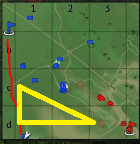
Type 89 is in a very weird spot for a light tank - on one hand it's relatively fast compared to average medium tank and has more combat ready weapons than average light tank, but it also isn't fast enough to get where it needs to be before enemy sniper tanks entrench in their hull-down spots. The armour of the tank is also quite lacking.
Traversing in open maps should be done with sniper positions in mind - something a Japan tree player should already know well by rank VI. Avoid being seen, while you are travelling, and if you cannot - ensure that range between you and hostile snipers aren't exceeding 1.5 km. This allows you to use your ATGM's as a deterrent mechanism, as you can launch them without stopping. Autocannons can only deter tanks as light as yours, and tanks like M3 Bradley will deflect APHE at long range, especially if they have high ground, and they know it, so only use missiles on them if you don't have APDS.
For example, on Mozdok single cap maps there is no cover whatsoever for light tank to strive, Arcade Battle mode Mozdok maps in particular are extremely deadly for Type 89, so in worst case scenario, main goal would be protecting your sniper group, as they try to reach their sniper spot by driving along with your party, scouting sniper positions with binoculars, and, as soon as anything that looks like a turret pokes out, launching a missile at them, to make them think twice.
In case if you actually managed to get next to enemy position, rather than your own sniper spot, you can either attempt to immediately destroy them in melee battle with autocannon, which is reasonable if enemy tanks are lightly armoured, like Centauro (attack only from the flank, from right side to avoid machine gun damage), or scout enemies around you to help your snipers, while you reload your ATGM in case if enemy got something heavily armoured as well, while waiting for opening.
It's needless to mention that Type 89 doesn't have radar and should not fight combat helicopters if they are attacking from 4 kilometers away, however if a helicopter at about 3 km away isn't moving much, you can use laser rangefinder and HE shells to cause damage to it. If you see a combat helicopter carrying dumbfire rockets and 40 mm grenade launcher, it is sometimes better to hide and let it pass or turn away, then shoot it in the back, as otherwise it will just unload the entire arsenal onto you, resulting in hull-break.
In urban environments, Type 89 is at the same time more powerful and weaker, as it's capable of destroying most tanks in 3 shots when they don't expect your attack, but it also can take only that much punishment frontally. Sometimes hostile tanks will intercept your tank only to set your engine compartment on fire - something that can buy you enough time to destroy them. The only real gripe is the attitude of chassis, which make you incapable of turning while moving forward until you hit gear 2, which makes you incapable of continuing assault, once you were stopped so use reverse or neutral steering for turning around and slight repositioning.
For the most part, as long as your reaction is good enough to fire first when enemy tank appears around the corner, you should be able to win. It is helpful to learn how to launch ATGM at 200 m ranges in town, as they don't exactly hit the mark before flying for 500 m. After it becomes second nature for you, launch it as soon as you see that you failed to hit new enemy tank by breaching their side armour and their turret starts to appear in your vision - you won't have much longer until they respond.
Modules
| Tier | Mobility | Protection | Firepower | |||
|---|---|---|---|---|---|---|
| I | Tracks | Parts | Horizontal Drive | |||
| II | Suspension | Brake System | FPE | Adjustment of Fire | LWS/LR | Airstrike |
| III | Filters | Crew Replenishment | Elevation Mechanism | NVD | ||
| IV | Transmission | Engine | Smoke grenade | Artillery Support | Improved optics | DM23 |
Pros and cons
Pros:
- Has 2 ATGM loaded at the same time and can fire them in quick succession
- Unlike other IFV and non-hybrid ATGM carriers, can fire ATGM on move and at any speed
- Type 79 ATGM is hard to dodge and have high penetration power of 700 mm - can breach ERA and weak NERA
- Potent ammunition for autocannon - able to take out enemy tanks with one or two well-aimed penetrating hits:
- Second strongest APHE shell on an infantry fighting vehicle
- With APDS shells, can fight most medium tanks
- High explosive round can be used to one-shot low flying aircraft
- Can very efficiently exchange speed to manoeuvrability at gears 2 and 3
- Neutral steering
- Good reverse speed, turns better in reverse than forward
- Has thermal sight
Cons:
- Weak armour - has hull break, can't completely negate damage, like the Warrior with add-on composite shields, can lose entire crew to a single 23 mm API-T and even APDS shot from the right side
- Low ammo count for the main gun and only 4 ATGM
- Due to placement of ATGM launchers on turret, firing them in close combat is awkward and may result in a non-fatal hit
- Unlike Type 60 ATM, ATGM only reloads after you fired both of loaded missiles, forcing you to waste ammunition, on top of having only four ATGMs
- ATGM reload takes 30 seconds, which is three times slower than any other light tank and specialized ATGM carrier
- Driver is not able to handle first forward gear turning of the tank, resulting in abysmal forward first-gear turning speed. The problem can be avoided by manually shifting the transmission to gear 2 or driving forward until driver does it himself, but IFV will stutter in close combat
History
At the beginning of the 1980s, the JSDF wanted to replace its outdated Type 60 and Type 73 APCs with more modern IFVs, similar to the American Bradley and the German Marder. The JSDF drew up a set of requirements and tasked the Mitsubishi company with developing a suitable replacement.
In 1984, funding was approved to build four different prototypes, all of which underwent testing until 1986. By 1989, one prototype design was selected and was adopted within the armed forces under the designation of Type 89.
Initially, the JSDF estimated the need for about 300 Type 89s to be built. However, the end of the Cold War in the 1990s combined with a limited budget prevented a rapid mass-production of Type 89 to take place. In fact, production was proceeding at a very low rate, with just over 50 vehicles entering service with the JSDF by 1999.
Although production of Type 89 was discontinued in 2004, the vehicle is still in service with the JSDF today. As of 2016, a total of 68 vehicles were present in the JSDF's inventory from the initially planned 300.
- From Devblog
Media
- Skins
- Videos
See also
Links to the articles on the War Thunder Wiki that you think will be useful for the reader, for example:
- reference to the series of the vehicles;
- links to approximate analogues of other nations and research trees.
External links
| Japan light tanks | |
|---|---|
| Type 89 | I-Go Ko |
| Type 95 | Ha-Go · Ha-Go Commander |
| Type 98 | Ke-Ni |
| Other | Ka-Mi |
| IFV | Type 89 |
| RCV | Type 87 RCV (P) · Type 87 RCV · RCV (P) |
| MCV | Type 16 (P) · Type 16 (FPS) · Type 16 |
| USA | ▅M24 · ▅M41A1 |


